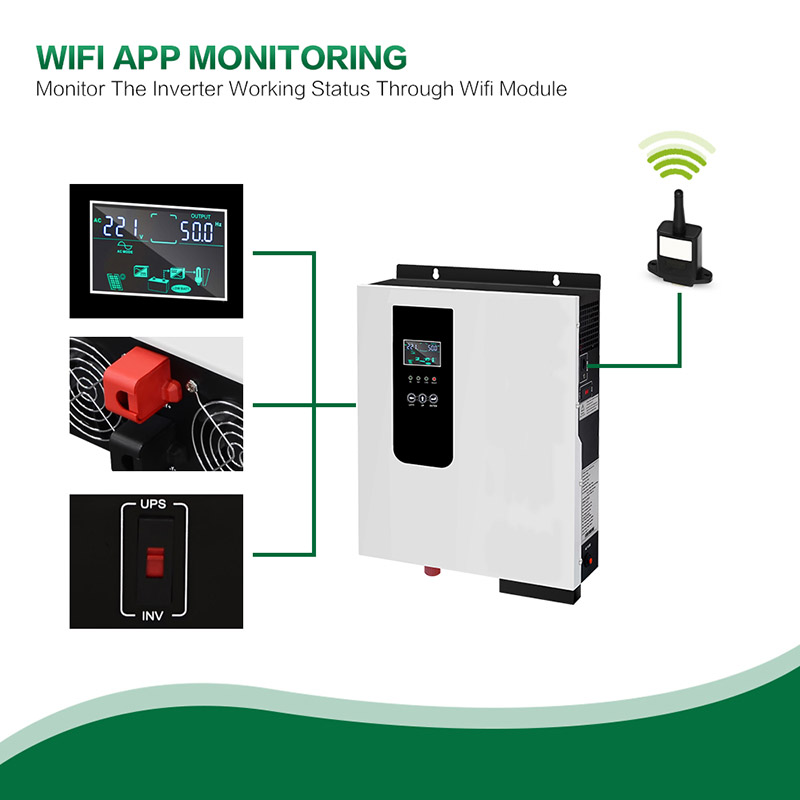Five development trends of photovoltaic high-frequency inverters
 Jul 19,2022
Jul 19,2022

 Rekesun
Rekesun
With the increasing diversification of photovoltaic power station types, higher challenges are raised for system design: large-scale ground power stations will still maintain a large market share; with the continuous improvement of policies, distributed power stations such as rooftops will develop rapidly; New applications such as fishery-photovoltaic complementarity and floating photovoltaics will increase. The selection of photovoltaic high-frequency inverters should reflect the basic principle of "according to local conditions and scientific design".
For large-scale ground photovoltaic power plants, centralized inverters have always been the mainstream solution. Lower initial investment, friendlier grid access, and lower-cost post-operation and maintenance are the main reasons for choosing centralized inverters. The actual operation data of multiple photovoltaic power stations show that in flat and unobstructed applications, the power generation of centralized and string-type inverters is the same; and the single-unit capacity of centralized inverters continues to increase, and the number of systems above 1MW will gradually increase; Inverter as a supplement, 40-100KW and other higher power string inverters will gradually replace 20-40KW string inverters.

For complementary fishing-light, floating on water, and large-scale rooftop photovoltaic power stations, the convenience of installation and maintenance needs to be considered: it needs to be installed as close as possible to the roadside; since the installation surface is flat, there are no different orientations, and there is no partial occlusion, multi-channel MPPT has no effect on power generation. Therefore, the centralized inverter is preferred; in a high-humidity environment, it is necessary to focus on the PID protection problem of the system; and the problem of maximizing the comprehensive income of photovoltaic systems and fish farming. String-type high-frequency inverters are mainly suitable for complex small hill power stations, agricultural greenhouses and complex roofs due to their small single-unit capacity, large number of MPPTs, and flexible configuration.
When it comes to the development trend of photovoltaic high-frequency inverter products, as the types of power stations become more and more complex, the product types of photovoltaic high-frequency inverters will be more diversified to meet the needs of different application scenarios. Specifically, it is mainly manifested in the following five aspects.
Trend 1: Centralized inverter power increases, efficiency increases, and voltage levels increase
Compared with the 1MW square array, the 2.5MW solution can reduce the cost by about 0.1 yuan/W, that is, the 100MW power station can reduce the initial investment of 10 million yuan. In addition, after the cable is matched, the loss of the DC part is guaranteed to be consistent.
It is worth mentioning that the 1500V system will be the development trend of large-scale power stations. Compared with the 1000V system, the investment of 0.2 yuan/W can be saved except for the components, which is equivalent to 20 million investment of the 100MW power station. At the same time, the system loss can be reduced by about 0.27%.
Trend 2: The single-unit power of string inverters continues to increase, and the power density increases
The power of string inverters has been continuously increased. At present, the maximum power has reached 80KW. The power density is also continuously improved, and the weight is continuously reduced to adapt to the complex application environment where installation and maintenance are difficult. Sungrow's 40KW string inverter has reached 39kg, which is the lightest 40KW product in the industry. . In terms of heat dissipation, Sungrow has always adhered to the method of intelligent fan heat dissipation to further reduce the temperature rise of internal components and improve the overload capacity of the inverter in high temperature environments. The fan protection grade used is IP65, the lifespan can reach 70,000 hours, and the fan can provide a 20-year warranty.
Trend 3: Component-level products (MLPE) are becoming more and more abundant
Component-level product categories are becoming more and more abundant. Shipments of module-level power electronics (MLPE) equipment are expected to increase from 1.1GW in 2013 to more than 5GW in 2017, according to industry researcher GTM.
Trend 4: The adaptability of the power grid is continuously enhanced, and various protections are improved to ensure safety and reliability
Leakage current protection, SVG function, LVRT, DC component protection, insulation resistance detection protection, PID protection, lightning protection, PV positive and negative reverse connection protection and other functions are continuously improved, and the adaptability of photovoltaic high-frequency inverters to the power grid is further enhanced , and continuously improve the protection function to make the system more secure and reliable.
Trend 5: The environmental adaptability of photovoltaic high-frequency inverters continues to improve
With the increasing application of photovoltaic power plants in various harsh environments such as coastal areas, deserts, and plateaus, the environmental adaptability of inverters such as corrosion resistance and wind and sand resistance has been continuously improved to ensure high reliability in harsh environments.
When talking about the development trend of photovoltaic systems, the application of various new technologies and new products will continuously promote the progress of photovoltaic technology, improve the system efficiency PR, reduce the cost per unit of electricity (LCOE) in the life cycle of the system, and finally achieve grid parity. common goal.
The design of the power station will be more refined; the system integration level will be further improved, and the integrated solution of integrated inverter and medium-voltage transformer can simplify the system to the extreme, while reducing costs, facilitating use, improving efficiency, and improving reliability.
"Photovoltaic + Internet" to realize the digitization of power stations. The power station management platform based on cloud storage and computing will be widely used. Through cloud computing and big data platform, the photovoltaic power station can be fully controlled in real time, with automatic operation and maintenance, and continuous optimization, so as to realize the intelligent operation, operation and maintenance management of photovoltaic power station, and improve the value of power station assets. , the operation management of the power station will be more intuitive and intelligent.
In addition, the combination of "photovoltaic + energy storage" will become an important part of solving the problem of abandoning light, smoothing output and building a smart microgrid system. In the past year, with the development of distributed photovoltaics in full swing, the energy storage industry has also begun to breeze. In addition to the well-known energy storage and solving the problem of abandoning wind and solar energy, energy storage can also be used for peak and frequency regulation of power grids, microgrids and household systems. It is understood that Sungrow's energy storage products have been applied in more than 100 projects.
In large-scale ground power stations, the initial investment of the centralized solution is lower, and the later operation and maintenance cost is only 1/3 of the string type. The operation results of multiple power stations show that the power generation capacity of the string type is the same as that of the centralized type, which is the first choice of users; the 2/2.5MW solution will become the mainstream next year; the application of photovoltaic high-frequency inverters in distributed More and more, high power, high efficiency and high power density are the future development directions; photovoltaic + Internet is recognized by the majority of customers, and digital and intelligent power stations are becoming the mainstream; photovoltaic + energy storage applications have broad prospects.



 Home
Home 4 Common High-Frequency Inverter Problems
4 Common High-Frequency Inverter Problems 







 syplighting.en.alibaba.com
syplighting.en.alibaba.com



